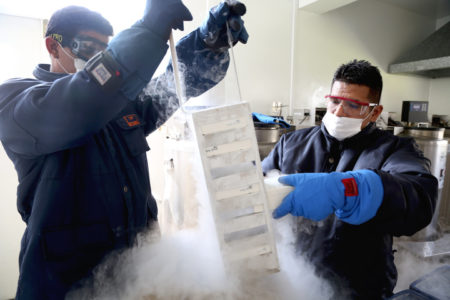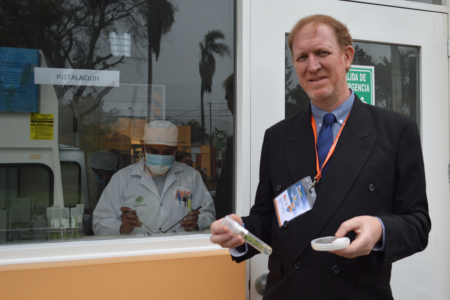
In response to advancing climate change and global population growth, crop breeders are striving to develop varieties that are more productive, resistant to disease, capable of growing in a changing climate, and with characteristics that farmers and consumers demand. Thus they can strengthen food security and help smallholders thrive in a challenging future.
The keys to developing these varieties lie in the vast genetic diversity of crops and their wild relatives, an agrobiodiversity that is largely preserved in the world’s genebanks. Most gene banks conserve agrobiodiversity in the form of seeds, but crops such as potato, sweetpotato and cassava, for which farmers plant a tuber or part of the plant, present a special challenge. Known as clonal spices, because the daughter plants are genetically identical to the parent plant, these crops have traditionally been conserved in the field or as tiny plants in vitro plants. An increasingly popular alternative is cryopreservation, conserving bits of plant tissue and organs at a temperature of -196°C.
Scientists from major gene banks in Latin America and the Caribbean are collaborating to facilitate the adoption of this innovation and thus strengthen the conservation of the genetic diversity of clonal species and those with recalcitrant seeds thanks to an initiative of the International Potato Center (CIP).
Clonal crops
The CIP Genebank maintains the most diverse collections of potato, sweetpotato, and Andean roots and tubers in the world with 16,200 unique accessions from 80 countries. CIP maintains its potato and sweetpotato collections as tiny in vitro plants in test tubes, which require renewal every year or two, a process that includes letting the plants grow and cutting stem segments from them that are grow into new plants. It is a laborious process that increases the cost of conservation and brings risks mixing up or contaminating accessions. Genebank scientists thus adopted cryopreservation, which is cheaper and more reliable than other clonal conservation methods in the long term and can preserve plants for decades or centuries.

Cryopreservation will play an important role in the conservation of agrobiodiversity, since clonal crops, which include roots, tubers and bananas, among others, contribute to the food and nutritional security of more than 300 million small-scale producers in developing countries. It is also an option for conserving species with recalcitrant seeds, such as mango or avocado, whose seeds do not resist drying and cold, and therefore can only be conserved for short periods.
According to Rainer Vollmer, who leads CIP’s cryopreservation efforts, the Center maintains the world’s largest potato cryobank with more than 4,200 cryopreserved accessions. Given the potential of this technology to strengthen the conservation of varied crops, Vollmer and Vania Azevedo, leader of the CIP Genebank and Global Program for Biodiversity for the Future, decided to launch an initiative to facilitate cryopreservation by Latin America’s genebanks, and conserve backup copies of any collections that are cryopreserved via a regional cryopreservation network.
“The purpose of having a cryopreservation network in Latin America is to facilitate communication between countries, support each other and share knowledge on issues related to the conservation of clonal species and species with recalcitrant seeds, so that together we can conserve these important crops in an integrated and long-term manner,” explained Azevedo.
“Agrobiodiversity, and biodiversity in general, is huge in Latin America,” Vollmer observed. “The objective of this initiative is to guarantee the conservation of the genetic resources of the most important clonal and recalcitrant crops in the long term in a reliable way, for the benefit of our grandchildren and great-grandchildren.”
Collaborative conservation
Like all CGIAR genebanks, the CIP Genebank safeguards and shares agrobiodiversity with scientists and farmers as a public good under the auspices of the International Treaty on Plant Genetic Resources for Food and Agriculture, administered by the Food and Agriculture Organization of United Nations (FAO). The process of creating a Latin American Cryopreservation Network began at the end of August 2022, when the FAO organized a preparatory meeting of the Latin American and Caribbean region for the ninth meeting of the Treaty’s Governing Body, held at CIP headquarters, in Lima, Peru. Azevedo and Vollmer organized the first cryopreservation workshop in Latin America for the two days before the FAO meeting.
“The objective of the workshop was to start a conversation with scientists from genebanks in Latin American countries about how we can together improve the conservation of clonal species, not only of the species that CIP conserves but of all the clonal species that they are key to agriculture and food in all the countries of the region,” Azevedo said.
The first outcome of the workshop was the creation of a community of practice with representatives of the national agricultural research systems of 14 countries in the region and two CGIAR centers – CIP and the Alliance of Bioversity International and the International Center for Tropical Agriculture. This community has been working virtually in the organization of cooperation and towards the creation of a regional network that is expected to formalize in 2023 or 2024. Many of the participating institutions are working to implement cryopreservation and four have already sent staff to the CIP headquarters for training in the cryopreservation process.

Azevedo explained that, in addition to sharing knowledge and training, CIP could host backup copies of the accessions from these cryobanks once they have been implemented.
The reaction of the workshop participants was quite positive. Aura Liz García Serquen, a specialist in genetic resources from the National Institute of Agrarian Innovation (INIA) of Peru, explained that INIA wants to collaborate with CIP to be able to use cryopreservation for the conservation of its potato and Andean root and tuber collections. Alvaro Monteros, a scientist at the National Institute for Agricultural Research (INIAP), Ecuador and an expert on that country’s native potatoes, explained that INIAP is already developing protocols and infrastructure to establish a cryobank. “Cryopreservation is a priority for INAP,” he said.
“Through this network, the germplasm banks of the region can support each other and share information on how to conserve clonal crops or recalcitrant seeds,” observed Monteros.
According to Fernanda Duarte Souza, a researcher at the Brazilian Agricultural Research Company (Embrapa), “The pandemic made very clear the importance of a technology such as cryopreservation to conserve genetic resources that are not from orthodox seeds safely, in the long term. ”
“This is a very important effort,” Souza said. “The Latin American and Caribbean region are cradles of biodiversity and this network will give us the opportunity to plan actions, divide responsibilities and guarantee that the genetic resources we conserve will be available for future generations.”
This work is supported by the Global Crop Diversity Trust and contributors to the CGIAR Trust Fund.
